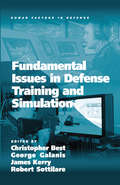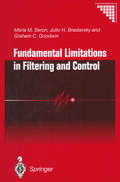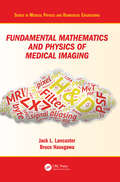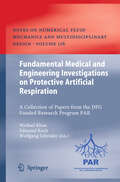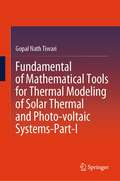- Table View
- List View
Fundamental Food Microbiology
by Bibek Ray Arun BhuniaThe golden era of food microbiology has begun. All three areas of food microbiology-beneficial, spoilage, and pathogenic microbiology-are expanding and progressing at an incredible pace. What was once a simple process of counting colonies has become a sophisticated process of sequencing complete genomes of starter cultures and use of biosensors to
Fundamental Food Microbiology (PDF)
by Bibek Ray Arun BhuniaMaintaining the high standard set by the previous bestselling editions, Fundamental Food Microbiology, Fourth Edition presents the most up-to-date information in this rapidly growing and highly dynamic field. Revised and expanded to reflect recent advances, this edition broadens coverage of foodborne diseases to include many new and emerging pathogens, as well as descriptions of the mechanism of pathogenesis. An entirely new chapter on detection methods appears with evaluations of advanced rapid detection techniques using biosensors and nanotechnology. With the inclusion of many more easy-to-follow figures and illustrations, this text provides a comprehensive introductory source for undergraduates, as well as a valuable reference for graduate level and working professionals in food microbiology or food safety.
Fundamental Generation Systems: Computer Science and Artificial Consciousness, the Informational Field of Generation of the Universe, the Sixth Sense of Living Beings
by Alain Cardon Abdelkhalak El HamiThere are many different ways of generating representations. This includes representations generated by living beings while comprehending reality in order to act; representations generated by the Universe during its extensive unfolding, creating physical elements and living beings; and the direct representation of elements through an animal’s sixth sense. To this list we must now add the creation of artificial consciousness, which generates representations that resemble the mental representations of humans. These representations allow robotic systems to communicate directly with each other.Fundamental Generation Systems develops a theory which presents, from the beginning, the function of this sixth sense called the “sense of informational comprehension”. This sense is understood as an ability to use the informational foundations of the Universe via a dedicated cerebral domain found in every animal.
Fundamental Generation Systems: Computer Science and Artificial Consciousness, the Informational Field of Generation of the Universe, the Sixth Sense of Living Beings
by Alain Cardon Abdelkhalak El HamiThere are many different ways of generating representations. This includes representations generated by living beings while comprehending reality in order to act; representations generated by the Universe during its extensive unfolding, creating physical elements and living beings; and the direct representation of elements through an animal’s sixth sense. To this list we must now add the creation of artificial consciousness, which generates representations that resemble the mental representations of humans. These representations allow robotic systems to communicate directly with each other.Fundamental Generation Systems develops a theory which presents, from the beginning, the function of this sixth sense called the “sense of informational comprehension”. This sense is understood as an ability to use the informational foundations of the Universe via a dedicated cerebral domain found in every animal.
Fundamental Issues in Control of Carbon Gasification Reactivity (NATO Science Series E: #192)
by L. Lahaye Pierre EhrburgerDuring the last decade there has been a renewed interest in under standing from a fundamental point of view the gasification of carbon. Basi cally there are two major issues in controlling the reactivity of carbon: i) reduction of the gasification rate of carbon materials in hostile environment ii) increase of the gasification rate in order to utilize carbonaceous compounds more effectively. Although these two objectives look somewhat contradictory, they are part of the general topics of understanding gasification reactivity of carbon. Refractory applications of carbon in furnace linings, seals and vanes, as well as the use of carbon-carbon or carbon-ceramic composites in struc tures able to withstand corrosion at high temperature require a better understanding of the fundamentals involved in carbon-oxidizing gas (02' CO , H 0) reactions. Furthermore a great interest of aluminium producers 2 2 is 10 extending the lifetime of carbon electrodes in alumina electrolysis which primarily depends on reducing their consumption rates by air or carbon dioxide. Proper control of gasification reactions is also of prime importance in manufacturing carbonaceous adsorbents like granular activated carbon clothes of high adsorption characteristics. The balance between increase of porosity and decrease in mechanical strength during activation is critical for developing new porous types of carbon materials in particular for carbon clothes and this can only be achieved by a careful control of the gasification reaction.
Fundamental Issues in Defense Training and Simulation (Human Factors in Defence)
by George Galanis Robert SottilareDefense forces have always invested a great deal of their resources in training. In recent times, changes in the complexity and intensity of operations have reaffirmed the importance of ensuring that warfighters are adequately prepared for the environments in which they are required to work. The emergence of new operational drivers such as asymmetric threats, urban operations, joint and coalition operations and the widespread use of military communications and information technology networks has highlighted the importance of providing warfighters with the competencies required to act in a coordinated, adaptable fashion, and to make effective decisions in environments characterized by large amounts of sometimes ambiguous information. While investment in new technologies can make available new opportunities for action, it is only through effective training that personnel can be made ready to apply their tools in the most decisive and discriminating fashion. There are many factors which can have an impact on the efficacy of training and many issues to consider when designing and implementing training strategies. These issues are often complex and nuanced, and in order to grasp them fully a significant investment of time and energy is required. However, the requirement to respond quickly to ever-changing technology, a high operational tempo and minimal staffing may preclude many in today's defense forces from seeking out all such resources on their own. This edited collection provides brief, easy-to-understand summaries of the key issues in defense training and simulation, as well as guidance for further reading. It consists of a collection of short essays, each of which addresses a fundamental issue in defense training and simulation, and features an up-to-date reference list to enable the reader to undertake further investigation of the issues addressed. In essence, this book provides the optimum starting point, or first resource, for readers to come to terms with the important issues associated with defense training and simulation. The contributions are written by leading scholars from military research institutions in the US, UK, Canada, Australia and New Zealand, as well as selected researchers from academic and private sector research institutions.
Fundamental Issues in Defense Training and Simulation (Human Factors in Defence)
by George Galanis Robert SottilareDefense forces have always invested a great deal of their resources in training. In recent times, changes in the complexity and intensity of operations have reaffirmed the importance of ensuring that warfighters are adequately prepared for the environments in which they are required to work. The emergence of new operational drivers such as asymmetric threats, urban operations, joint and coalition operations and the widespread use of military communications and information technology networks has highlighted the importance of providing warfighters with the competencies required to act in a coordinated, adaptable fashion, and to make effective decisions in environments characterized by large amounts of sometimes ambiguous information. While investment in new technologies can make available new opportunities for action, it is only through effective training that personnel can be made ready to apply their tools in the most decisive and discriminating fashion. There are many factors which can have an impact on the efficacy of training and many issues to consider when designing and implementing training strategies. These issues are often complex and nuanced, and in order to grasp them fully a significant investment of time and energy is required. However, the requirement to respond quickly to ever-changing technology, a high operational tempo and minimal staffing may preclude many in today's defense forces from seeking out all such resources on their own. This edited collection provides brief, easy-to-understand summaries of the key issues in defense training and simulation, as well as guidance for further reading. It consists of a collection of short essays, each of which addresses a fundamental issue in defense training and simulation, and features an up-to-date reference list to enable the reader to undertake further investigation of the issues addressed. In essence, this book provides the optimum starting point, or first resource, for readers to come to terms with the important issues associated with defense training and simulation. The contributions are written by leading scholars from military research institutions in the US, UK, Canada, Australia and New Zealand, as well as selected researchers from academic and private sector research institutions.
Fundamental Limitations in Filtering and Control (Communications and Control Engineering)
by Maria M. Seron Julio H. Braslavsky Graham C. GoodwinThis book deals with the issue of fundamental limitations in filtering and control system design. This issue lies at the very heart of feedback theory since it reveals what is achievable, and conversely what is not achievable, in feedback systems. The subject has a rich history beginning with the seminal work of Bode during the 1940's and as subsequently published in his well-known book Feedback Amplifier Design (Van Nostrand, 1945). An interesting fact is that, although Bode's book is now fifty years old, it is still extensively quoted. This is supported by a science citation count which remains comparable with the best contemporary texts on control theory. Interpretations of Bode's results in the context of control system design were provided by Horowitz in the 1960's. For example, it has been shown that, for single-input single-output stable open-loop systems having rela tive degree greater than one, the integral of the logarithmic sensitivity with respect to frequency is zero. This result implies, among other things, that a reduction in sensitivity in one frequency band is necessarily accompa nied by an increase of sensitivity in other frequency bands. Although the original results were restricted to open-loop stable systems, they have been subsequently extended to open-loop unstable systems and systems having nonminimum phase zeros.
Fundamental Mass Transfer Concepts in Engineering Applications
by Ismail TosunFundamental Mass Transfer Concepts in Engineering Applications provides the basic principles of mass transfer to upper undergraduate and graduate students from different disciplines. This book outlines foundational material and equips students with sufficient mathematical skills to tackle various engineering problems with confidence. It covers mass transfer in both binary and multicomponent systems and integrates the use of Mathcad® for solving problems. This textbook is an ideal resource for a one-semester course. Key Features The concepts are explained with the utmost clarity in simple and elegant language Presents theory followed by a variety of practical, fully-worked example problems Includes a summary of the mathematics necessary for mass transfer calculations in an appendix Provides ancillary Mathcad® subroutines Includes end-of-chapter problems and a solutions manual for adopting instructors
Fundamental Mass Transfer Concepts in Engineering Applications
by Ismail TosunFundamental Mass Transfer Concepts in Engineering Applications provides the basic principles of mass transfer to upper undergraduate and graduate students from different disciplines. This book outlines foundational material and equips students with sufficient mathematical skills to tackle various engineering problems with confidence. It covers mass transfer in both binary and multicomponent systems and integrates the use of Mathcad® for solving problems. This textbook is an ideal resource for a one-semester course. Key Features The concepts are explained with the utmost clarity in simple and elegant language Presents theory followed by a variety of practical, fully-worked example problems Includes a summary of the mathematics necessary for mass transfer calculations in an appendix Provides ancillary Mathcad® subroutines Includes end-of-chapter problems and a solutions manual for adopting instructors
Fundamental Mathematical Concepts for Machine Learning in Science
by Umberto MichelucciThis book is for individuals with a scientific background who aspire to apply machine learning within various natural science disciplines—such as physics, chemistry, biology, medicine, psychology and many more. It elucidates core mathematical concepts in an accessible and straightforward manner, maintaining rigorous mathematical integrity. For readers more versed in mathematics, the book includes advanced sections that are not prerequisites for the initial reading. It ensures concepts are clearly defined and theorems are proven where it's pertinent. Machine learning transcends the mere implementation and training of algorithms; it encompasses the broader challenges of constructing robust datasets, model validation, addressing imbalanced datasets, and fine-tuning hyperparameters. These topics are thoroughly examined within the text, along with the theoretical foundations underlying these methods. Rather than concentrating on particular algorithms this book focuses on the comprehensive concepts and theories essential for their application. It stands as an indispensable resource for any scientist keen on integrating machine learning effectively into their research. Numerous texts delve into the technical execution of machine learning algorithms, often overlooking the foundational concepts vital for fully grasping these methods. This leads to a gap in using these algorithms effectively across diverse disciplines. For instance, a firm grasp of calculus is imperative to comprehend the training processes of algorithms and neural networks, while linear algebra is essential for the application and efficient training of various algorithms, including neural networks. Absent a solid mathematical base, machine learning applications may be, at best, cursory, or at worst, fundamentally flawed. This book lays the foundation for a comprehensive understanding of machine learning algorithms and approaches.
Fundamental Mathematical Modeling of Additive Manufacturing (Springer Tracts in Additive Manufacturing)
by Juha Jeronen Tero Tuovinen Matti KurkiThis book elucidates the fundamental thermomechanical behaviour inherent in the 3D printing process within a laser-based powder bed fusion (L-PBF) system. It presents foundational concepts and provides in-depth derivations of the governing equations. The analysis encompasses arbitrary anisotropic linear viscoelastic materials, accounting for thermal effects. The authors leverage the theory of axially moving materials, a framework previously employed in the analysis of production processes within the process industry. They introduce a coordinate frame that moves in tandem with the printing laser, adopting an Eulerian perspective towards the in-motion solid. Designed for graduate students and researchers, this book is poised to foster a profound comprehension and spur innovative technological advancements in the realm of additive manufacturing.
Fundamental Mathematics and Physics of Medical Imaging (Series in Medical Physics and Biomedical Engineering)
by Jack Lancaster Bruce HasegawaAuthored by a leading educator, this book teaches the fundamental mathematics and physics concepts associated with medical imaging systems. Going beyond mere description of imaging modalities, this book delves into the mechanisms of image formation and image quality common to all imaging systems: contrast mechanisms, noise, and spatial and temporal resolution, making it an important reference for medical physicists and biomedical engineering students. This is an extensively revised new edition of The Physics of Medical X-Ray Imaging by Bruce Hasegawa (Medical Physics Publishing, 1991), and includes a wide range of modalities such as X-ray CT, MRI and SPECT.
Fundamental Mathematics and Physics of Medical Imaging (Series in Medical Physics and Biomedical Engineering)
by Jack Lancaster Bruce HasegawaAuthored by a leading educator, this book teaches the fundamental mathematics and physics concepts associated with medical imaging systems. Going beyond mere description of imaging modalities, this book delves into the mechanisms of image formation and image quality common to all imaging systems: contrast mechanisms, noise, and spatial and temporal resolution, making it an important reference for medical physicists and biomedical engineering students. This is an extensively revised new edition of The Physics of Medical X-Ray Imaging by Bruce Hasegawa (Medical Physics Publishing, 1991), and includes a wide range of modalities such as X-ray CT, MRI and SPECT.
Fundamental Mechanics of Fluids
by I. G. CurrieFundamental Mechanics of Fluids, Fourth Edition addresses the need for an introductory text that focuses on the basics of fluid mechanics-before concentrating on specialized areas such as ideal-fluid flow and boundary-layer theory. Filling that void for both students and professionals working in different branches of engineering, this versatile ins
Fundamental Mechanics of Fluids
by Iain G. Currie I. G. CurrieRetaining the features that made previous editions perennial favorites, Fundamental Mechanics of Fluids, Third Edition illustrates basic equations and strategies used to analyze fluid dynamics, mechanisms, and behavior, and offers solutions to fluid flow dilemmas encountered in common engineering applications. The new edition contains completely re
Fundamental Mechanics of Fluids
by I.G. CurrieFundamental Mechanics of Fluids, Fourth Edition addresses the need for an introductory text that focuses on the basics of fluid mechanics-before concentrating on specialized areas such as ideal-fluid flow and boundary-layer theory. Filling that void for both students and professionals working in different branches of engineering, this versatile ins
Fundamental Medical and Engineering Investigations on Protective Artificial Respiration: A Collection of Papers from the DFG funded Research Program PAR (Notes on Numerical Fluid Mechanics and Multidisciplinary Design #116)
by Michael Klaas Edmund Koch Wolfgang SchröderThis volume contains a collection of papers from the research program “Protective Artificial Respiration (PAR)”. In 2005 the German Research Association DFG launched the research program PAR which is a joint initiative of medicine and fluid mechanics. The main long-term objective of this program is the development of a more protective artificial respiratory system to reduce the physical stress of patients undergoing artificial respiration. To satisfy this goal 11 projects have been defined. In each of these projects scientists from medicine and fluid mechanics do collaborate in several experimental and numerical investigations to improve the fundamental knowledge on respiration and to develop a more individual artificial breathing concept.
Fundamental Numerical Methods for Electrical Engineering (Lecture Notes in Electrical Engineering #18)
by Stanislaw RosloniecStormy development of electronic computation techniques (computer systems and software), observed during the last decades, has made possible automation of data processing in many important human activity areas, such as science, technology, economics and labor organization. In a broadly understood technology area, this developmentledtoseparationofspecializedformsofusingcomputersforthedesign and manufacturing processes, that is: – computer-aided design (CAD) – computer-aided manufacture (CAM) In order to show the role of computer in the rst of the two applications m- tioned above, let us consider basic stages of the design process for a standard piece of electronic system, or equipment: – formulation of requirements concerning user properties (characteristics, para- ters) of the designed equipment, – elaboration of the initial, possibly general electric structure, – determination of mathematical model of the system on the basis of the adopted electric structure, – determination of basic responses (frequency- or time-domain) of the system, on the base of previously established mathematical model, – repeated modi cation of the adopted diagram (changing its structure or element values) in case, when it does not satisfy the adopted requirements, – preparation of design and technological documentation, – manufacturing of model (prototype) series, according to the prepared docum- tation, – testing the prototype under the aspect of its electric properties, mechanical du- bility and sensitivity to environment conditions, – modi cation of prototype documentation, if necessary, and handing over the documentation to series production. The most important stages of the process under discussion are illustrated in Fig. I. 1. xi xii Introduction Fig. I.
Fundamental of Mathematical Tools for Thermal Modeling of Solar Thermal and Photo-voltaic Systems-Part-I
by Gopal Nath TiwariThe textbook book discusses the basics required to understand various application of solar energy. It covers basic mathematical tools required to analyze any solar thermal (ST), photo-voltaic (PV), and photo-voltaic thermal (PVT) system. The book provides a platform for undergraduate, postgraduate, researchers, and entrepreneurs to optimize the basic parameters for best performance of any system based on solar energy. The book includes about 500 examples that the reader can use to better understand the subject.
Fundamental of Transport Phenomena and Metallurgical Process Modeling
by Sujay Kumar DuttaThis textbook presents the fundamental of transport phenomena and metallurgical process modeling in easy-to-understand format. It covers all the important and basic concepts, derivations and numerical problems for the undergraduate and graduate engineering students. It includes topics such as fluid dynamics, mass and momentum balances, mass transfer, basic concepts of models and applications. This textbook can also be used as a reference book by engineers, professionals and research scientists to gain better understanding on mass and heat balances. Given the contents, this textbook will be highly useful for the core course of transport phenomena in metallurgical processes for graduate and advanced graduate students in various engineering disciplines. This textbook will also serve as a refresher course for advanced graduate students who are engaged in research related to transport phenomena and metallurgical processes.
Fundamental Physics of Amorphous Semiconductors: Proceedings of the Kyoto Summer Institute Kyoto, Japan, September 8—11, 1980 (Springer Series in Solid-State Sciences #25)
by F. YonezawaThe Kyoto Summer Institute 1980 (KSI '80), devoted to "Fundamental Physics of Amorphous Semiconductors", was held at Research Institute for Fundamental Physics (RIFP), Kyoto University, from 8-11 September, 1980. The KSI '80 was the successor of the preceding Institutes which were held in July 1978 on "Particle Physics and Accelerator Projects" and in September 1979 on "Physics of Low-Dimensional Systems". The KSI '80 was attended by 200 participants, of which 36 were from abroad: Canada, France, Korea, Poland, U.K., U.S.A, U.S.S.R., and the Federal Republic of Germany. The KSI '80 was organized by RIFP and directed by the Amorphous Semicon ductor group in Japan. A few years ago, we started to organize an interna tional meeting on amorphous semiconductors' as a satell ite meeting of the International Conference on "Physics of Semiconductors" held on September 1-5, 1980 in Kyoto. We later decided to hold the meeting in the form of the Kyoto Summer Institute. The Kyoto Summer Institute is aimed to be something between a school and a conference. Accordingly, the object of the KSI '80 was to provide a series of invited lectures and informal seminars on fundamental physics of amorphous semiconductors. No contributed paper was accepted, but seminars were open.
Fundamental Polymer Science (Graduate Texts in Physics)
by Ulf W. Gedde Mikael S. HedenqvistThis successor to the popular textbook, “Polymer Physics” (Springer, 1999), is the result of a quarter-century of teaching experience as well as critical comments from specialists in the various sub-fields, resulting in better explanations and more complete coverage of key topics. With a new chapter on polymer synthesis, the perspective has been broadened significantly to encompass polymer science rather than “just” polymer physics. Polysaccharides and proteins are included in essentially all chapters, while polyelectrolytes are new to the second edition. Cheap computing power has greatly expanded the role of simulation and modeling in the past two decades, which is reflected in many of the chapters. Additional problems and carefully prepared graphics aid in understanding. Two principles are key to the textbook’s appeal: 1) Students learn that, independent of the origin of the polymer, synthetic or native, the same general laws apply, and 2) students should benefit from the book without an extensive knowledge of mathematics. Taking the reader from the basics to an advanced level of understanding, the text meets the needs of a wide range of students in chemistry, physics, materials science, biotechnology, and civil engineering, and is suitable for both masters- and doctoral-level students. Praise for the previous edition: ...an excellent book, well written, authoritative, clear and concise, and copiously illustrated with appropriate line drawings, graphs and tables. - Polymer International ...an extremely useful book. It is a pleasure to recommend it to physical chemists and materials scientists, as well as physicists interested in the properties of polymeric materials. - Polymer News This valuable book is ideal for those who wish to get a brief background in polymer science as well as for those who seek a further grounding in the subject. - Colloid Polymer Science The solutions to the exercises are given in the final chapter, making it a well thought-out teaching text. - Polymer Science
Fundamental Principles for the Illumination of a Picture Gallery: Together with their Application to the Illumination of the Municipal Museum at the Hague
by Johanna Geertruida EymersFundamental Principles of Environmental Physics
by Abel Rodrigues Raul Albuquerque Sardinha Gabriel PitaThis book is an interdisciplinary and accessible guide to environmental physics. It allows readers to gain a more complete understanding of physical process and their interaction with ecological ones underpin important environmental issues.The book covers a wide range of topics within environmental physics, including:• natural and anthropogenic canopies, including forests, urban or wavy terrains;• the fundamentals of heat transfer;• atmospheric flow dynamics;• global carbon budget;• climate change; and• the relevance of biochar as a global carbon sink.Including solved exercises, numerous illustrations and tables, as well as an entire chapter focused on applications, book is of interest to researchers, students and industrial engineers alike.




